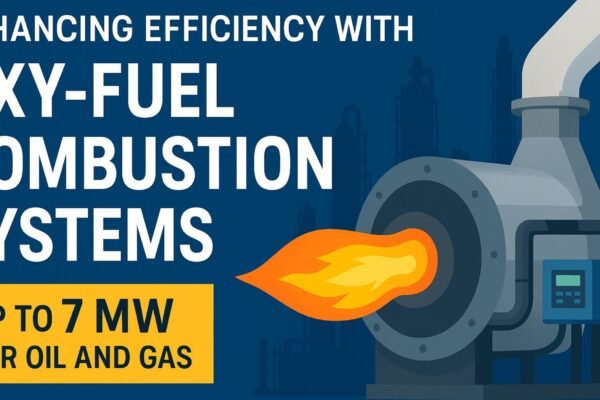🔥 Introduction: The Rising Concern of Industrial Emissions
In today’s environmentally conscious industrial landscape, emission control has become more critical than ever. Among the most harmful pollutants from combustion processes are nitrogen oxides (NOx) and sulfur oxides (SOx), which contribute significantly to acid rain, smog, and respiratory issues.
Industries relying on high-temperature processes—like steel, glass, cement, and ceramics—are under increasing pressure to adopt clean technologies. That’s where Oxy-Fuel Combustion Emission Control becomes a game-changer.
This blog explores how oxy-fuel combustion helps in NOx emission reduction in combustion systems and mitigates SOx emissions from industrial furnaces, all while improving energy efficiency.
🔬 What Is Oxy-Fuel Combustion?
Oxy-fuel combustion is a process where pure oxygen is used instead of air for combustion. Unlike air, which contains only 21% oxygen and 78% nitrogen, using pure oxygen eliminates nitrogen from the combustion equation—drastically reducing NOx formation.
The result?
- Higher flame temperatures
- Lower flue gas volume
- Better thermal efficiency
- Dramatically reduced emissions
💨 How Oxy-Fuel Combustion Reduces NOx Emissions
🔹 Eliminates Nitrogen from the Combustion Process
The primary reason for NOx emission reduction in combustion systems lies in removing atmospheric nitrogen from the combustion air. With no nitrogen present, thermal NOx formation drops significantly.
🔹 Controlled Flame Temperature
While oxy-fuel combustion increases flame temperature, advanced systems can moderate it using flue gas recirculation (FGR), further minimizing NOx.
🔹 Use of Low NOx Oxy-Fuel Burners
Modern burners are designed to control flame shape and mixing, further optimizing the combustion profile to reduce NOx formation at the source.
🌫️ Controlling SOx Emissions Using Oxy-Fuel Combustion
🔹 Reduced Fuel Consumption = Lower SOx
Since oxy-fuel combustion improves thermal efficiency, it burns less fuel for the same output, leading to lower sulfur input in the furnace—and thus, reduced SOx emissions from industrial furnaces.
🔹 Cleaner Combustion
High flame temperatures and controlled oxidation conditions ensure more complete combustion, leaving less sulfur unburnt.
🔹 Lower Flue Gas Volume
Reduced flue gas output leads to higher SOx concentration but in a lower overall volume—making downstream gas treatment easier and more efficient.
🏭 Industrial Applications of Oxy-Fuel Combustion
At Encon Thermal Engineers, we have implemented Oxy-Fuel Combustion Emission Control systems in the following sectors:
- Steel Reheating Furnaces: Improved heat transfer, reduced NOx emissions
- Glass Melting Furnaces: Cleaner combustion and energy savings
- Ceramics & Refractories: Uniform heating and emission control
- Aluminum Industry: Reduced oxidation loss and lower emissions
⚙️ System Components and Design
An effective oxy-fuel combustion setup includes:
- Oxygen supply (from onsite plant or cylinder banks)
- Oxy-fuel burners (with or without FGR)
- Combustion chamber modifications
- Optional flue gas treatment or heat recovery system
- Advanced PLC/SCADA for control and safety
We at Encon customize these solutions based on furnace size, fuel type, emission regulations, and production goals.
📈 Benefits Beyond Emission Control
Oxy-fuel systems offer more than just environmental compliance:
Benefit | Description |
✅ Energy Savings | Up to 30% fuel reduction in some applications |
✅ Higher Productivity | Faster heating leads to shorter cycle times |
✅ Reduced Scale Formation | Cleaner combustion reduces metal oxidation |
✅ Smaller Chimneys | Lower flue gas volume means compact exhaust setups |
✅ ROI in 1–2 Years | Lower fuel cost and maintenance justify upfront investment |
🌍 Regulatory Landscape: Why Compliance Is Non-Negotiable
Indian industries are now under tighter emission norms via CPCB guidelines and State Pollution Control Boards. Globally, countries are aligning with the Paris Agreement to cap GHG and pollutant levels.
In this environment, NOx and SOx emission control is no longer a luxury—it’s a regulatory necessity.
🧠 Why Choose Encon Thermal Engineers?
- ✅ 40+ Years of Combustion Engineering Expertise
- ✅ Customized Low NOx Burner Systems
- ✅ On-site Evaluation & Retrofitting
- ✅ Proven Results in Multiple Industrial Sectors
- ✅ Turnkey Installation & Post-Sales Support
Whether you’re planning new infrastructure or upgrading an old furnace, our Oxy-Fuel Combustion Emission Control solutions ensure compliance, efficiency, and peace of mind.
📢 Final Thoughts: Clean Heat is the Future
As industries move towards decarbonization and sustainable manufacturing, integrating oxy-fuel combustion systems becomes a strategic imperative. It offers a clear path to NOx emission reduction in combustion systems, significant drop in SOx emissions, and improved furnace performance.
📞 Call to Action
Want to reduce emissions and boost furnace efficiency?
📲 Contact Encon Thermal Engineers today to explore custom-built Oxy-Fuel Combustion Emission Control systems that meet your industrial needs and regulatory goals.







